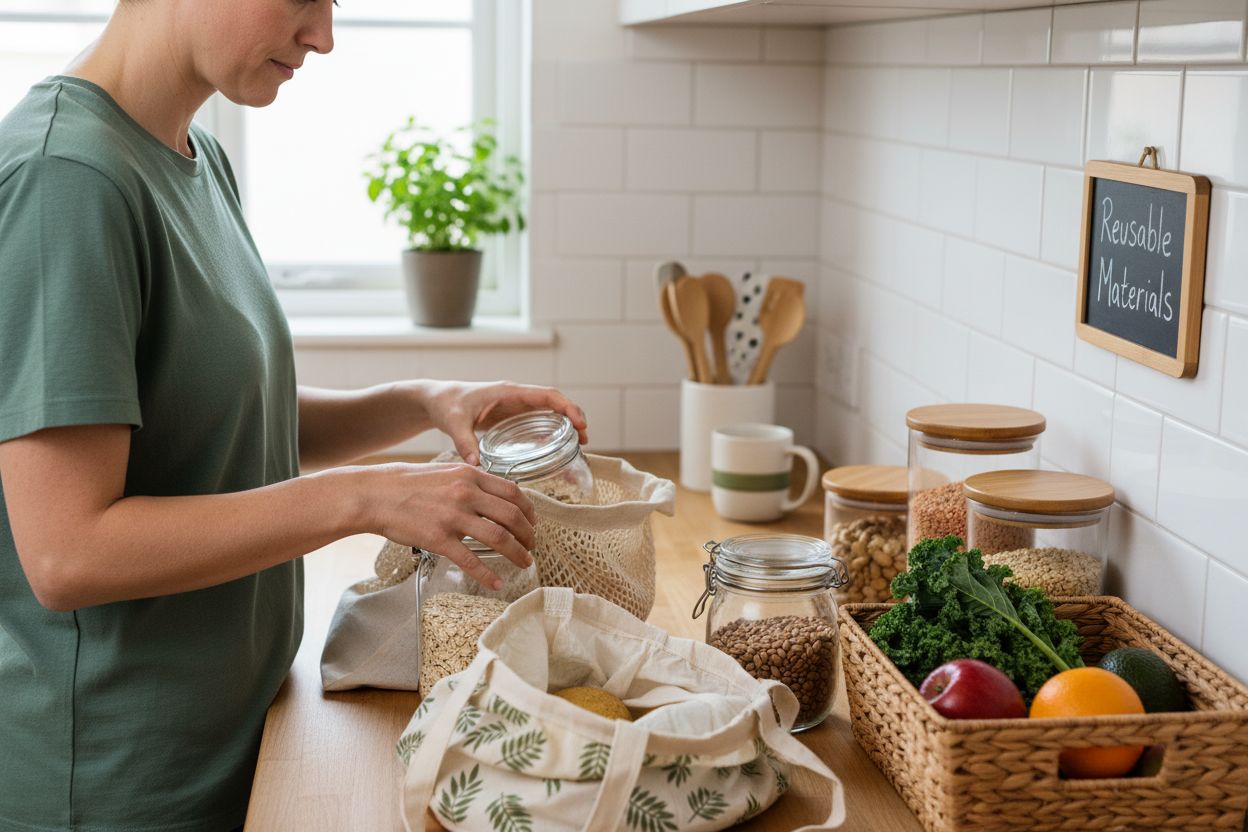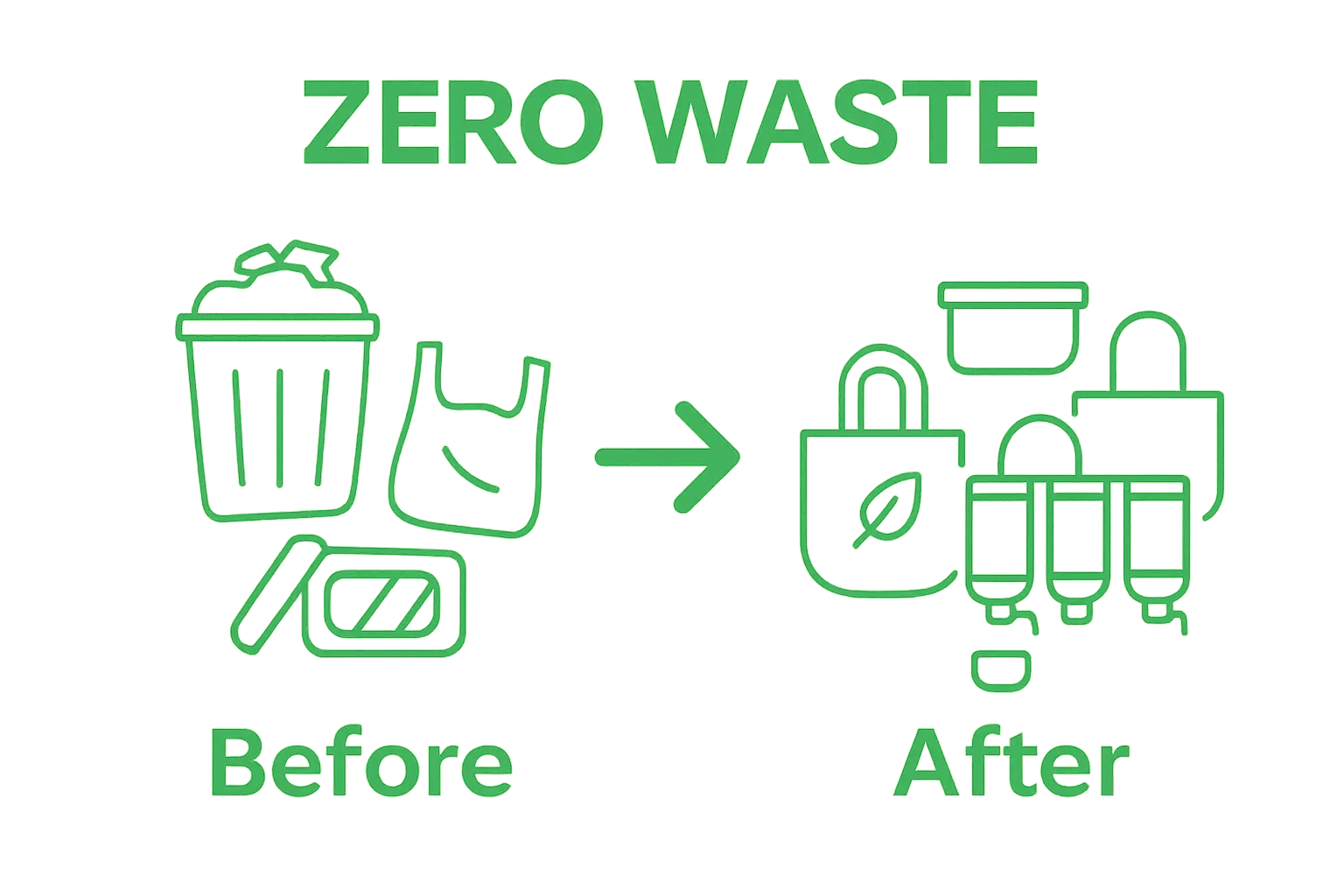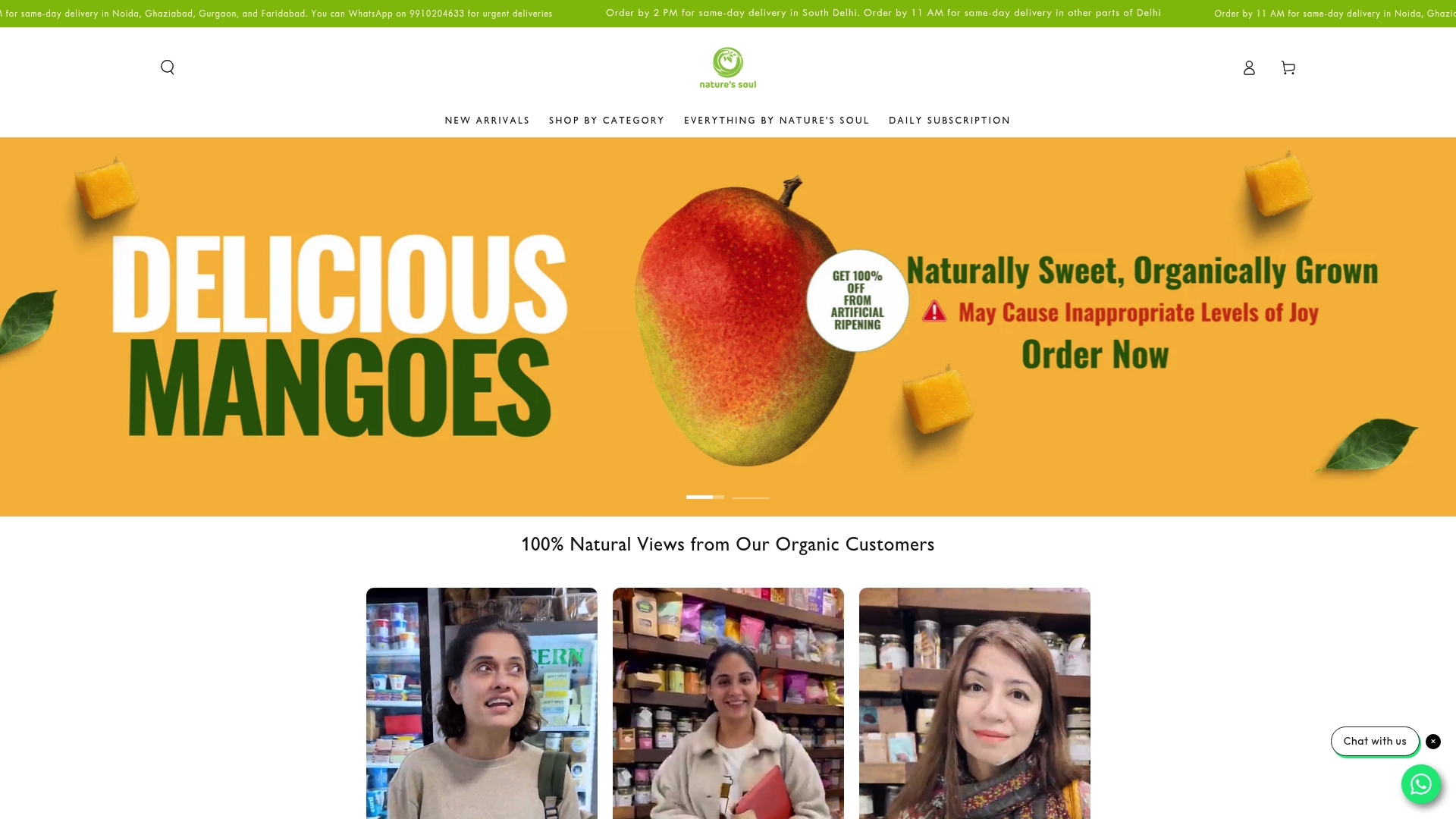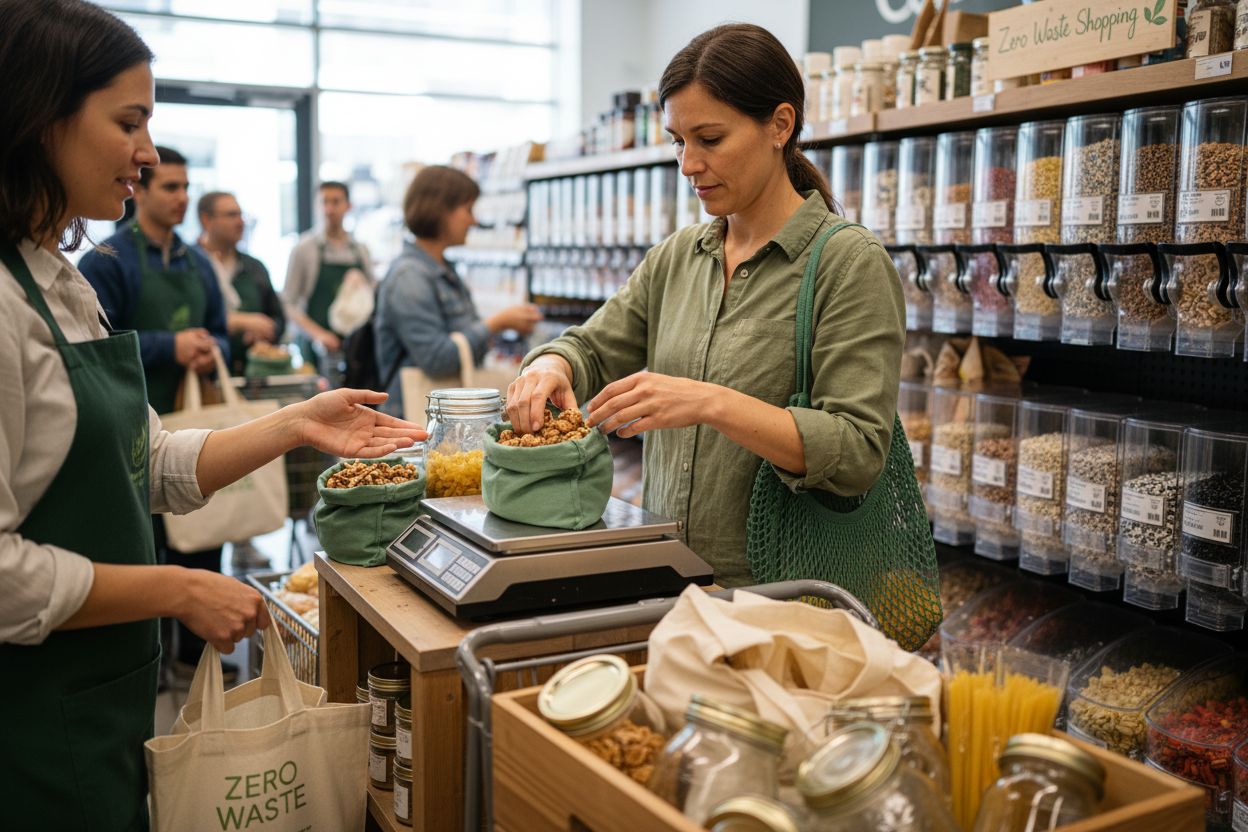Zero waste grocery shopping is becoming more than just a trend for eco-conscious shoppers, especially now that over 30 percent of all purchased food in the UK gets thrown away. Most people feel that buying with good intentions is enough. Shopping bags still fill with single use packaging and ‘just in case’ ingredients destined for the bin. Switching to zero waste isn’t about buying special products or spending more money. It all begins with a surprisingly simple shift in your weekly habits.
Table of Contents
- Step 1: Assess Your Current Grocery Habits
- Step 2: Create A Shopping List With Zero Waste In Mind
- Step 3: Choose Sustainable Grocery Stores And Local Markets
- Step 4: Prepare Reusable Materials For Your Shopping Trip
- Step 5: Implement Mindful Shopping Techniques
- Step 6: Evaluate Your Purchases And Adjust For Next Time
Quick Summary
| Key Point | Explanation |
|---|---|
| 1. Track your grocery habits | Document purchases and waste for a week to identify waste points. This insight helps in planning targeted reductions in consumption. |
| 2. Create a mindful shopping list | Develop a list prioritising bulk items and minimal packaging to prevent impulse buying and excess waste. This enhances intentional shopping behaviour. |
| 3. Choose sustainable grocery stores | Select stores offering bulk options and minimal packaging. This choice supports sustainable shopping practices and reduces your environmental impact. |
| 4. Prepare reusable materials | Assemble a kit of reusable bags and containers for your shopping trips. This preparation is crucial for avoiding single-use packaging during purchases. |
| 5. Reflect on shopping trips | Evaluate your purchases after shopping to identify areas for improvement. This ongoing assessment refines your approach to further align with zero waste goals. |
Step 1: Assess your current grocery habits
Zero waste grocery shopping starts with understanding your current consumption patterns. Before making significant changes, you need a clear snapshot of how you currently purchase and use groceries. This initial assessment will reveal waste points and help you develop targeted strategies for reduction.
Begin by tracking your grocery purchases and food waste for one complete week. Keep a simple journal or use a dedicated smartphone app to document everything you buy and discard. Pay close attention to packaging types, quantities of food wasted, and recurring purchasing habits. Note items that frequently end up in the bin unopened or half consumed. Are you buying too much produce that spoils before consumption? Do packaged goods dominate your shopping basket?
Documenting your habits requires honest self reflection. Learn more about mindful consumption habits from environmental experts who recommend detailed tracking. Your journal should capture specific details such as:
- Total grocery spending
- Quantity of food discarded
- Types of packaging encountered
- Frequency of impulse purchases
- Proportion of fresh versus packaged items
As you compile this information, look for patterns that indicate potential waste. Overbuying perishables, purchasing excessive packaged goods, or buying items that rarely get consumed are common culprits. By objectively examining your current grocery shopping behaviour, you create a foundation for meaningful zero waste transformations. The insights gathered during this assessment will directly inform your strategy in subsequent steps, helping you make targeted, sustainable changes to your shopping approach.
Step 2: Create a shopping list with zero waste in mind
Transforming your grocery shopping begins with strategic planning. A thoughtfully crafted shopping list is your primary weapon against unnecessary waste, impulsive purchases, and excess packaging. Your list becomes a roadmap for intentional, sustainable consumption that directly supports zero waste grocery shopping objectives.
Start by reviewing your waste tracking journal from the previous step. Identify staple items you consistently use and consume completely. Plan meals in advance, focusing on ingredients that can be purchased with minimal or no packaging. Consider purchasing whole ingredients rather than pre prepared or packaged alternatives. Learn more about mindful meal planning to streamline your zero waste approach.
Prepare your shopping list with precision and purpose. Group items by category and prioritize bulk purchases, loose produce, and products with minimal packaging. Bring reusable containers and bags to store these items directly during shopping. Your list should include specific quantities to prevent overbuying perishable goods. Consider these strategic approaches:
- Plan meals for the entire week
- Purchase only the exact quantities needed
- Prioritize local and seasonal produce
- Select items with recyclable or compostable packaging
Successful zero waste grocery shopping requires flexibility and continuous refinement. Each shopping trip provides an opportunity to adjust your strategy, reduce waste incrementally, and develop more sustainable consumption habits. By transforming your shopping list from a simple inventory to a deliberate waste reduction tool, you create meaningful change in your everyday grocery experience.
Step 3: Choose sustainable grocery stores and local markets
Selecting the right grocery shopping environment is crucial in your zero waste journey. Not all stores are created equal when it comes to sustainable practices and packaging reduction. Your shopping location can significantly impact your ability to minimize waste and make environmentally conscious choices.
Begin by researching local markets, farmers markets, and independent grocery stores that prioritize sustainability. These venues often offer more flexibility with packaging and provide opportunities to purchase items without unnecessary plastic wrapping. Explore sustainable agriculture practices to understand the broader context of mindful food consumption.
When evaluating potential shopping locations, look for stores with specific zero waste features. Seek out establishments that encourage customers to bring their own containers, offer bulk purchasing options, and display a commitment to reducing packaging waste. Some progressive grocery stores now provide dedicated sections for package free shopping, allowing you to fill your own reusable containers directly from dispensers.
Consider these critical factors when selecting your zero waste grocery shopping destinations:
- Proximity to bulk food sections
- Willingness to accommodate reusable containers
- Range of unpackaged produce and ingredients
- Support for local and organic farmers
- Transparent sourcing and sustainability practices
Remember that transitioning to zero waste grocery shopping is a gradual process. You might not find a perfect store immediately, but each small choice moves you closer to your sustainability goals. Experiment with different markets, build relationships with local vendors, and remain flexible in your approach.
Step 4: Prepare reusable materials for your shopping trip
Setting up your zero waste grocery shopping toolkit is a critical step in reducing unnecessary packaging and waste. Preparation is key to ensuring a smooth, environmentally conscious shopping experience. Your reusable materials are not just accessories but essential tools in transforming your grocery shopping habits.
Start by assembling a comprehensive collection of reusable containers, bags, and storage solutions. Consider investing in a variety of sizes and materials that can handle different types of groceries. Glass jars, cloth bags, mesh produce bags, and durable shopping totes will become your primary weapons against single use packaging. Learn more about sustainable eating practices that complement your zero waste approach.
Before each shopping trip, take time to clean and organize your reusable materials. Ensure containers are thoroughly washed, bags are free from previous debris, and everything is neatly arranged for easy access. Weight and durability matter when selecting your shopping gear. Lightweight cotton bags for produce, sturdy glass containers for bulk items, and insulated bags for temperature sensitive products will help you navigate different shopping scenarios effectively.
Consider creating a dedicated zero waste shopping kit that includes:
- Multiple reusable shopping bags
- Different sized glass and stainless steel containers
- Lightweight mesh produce bags
- Small cloth bags for bulk dry goods
- Insulated bag for refrigerated items
Remember that building a zero waste shopping routine takes practice. You might forget a container or make mistakes initially, but each trip becomes smoother as you develop your system. Stay flexible, learn from each experience, and continuously refine your approach to sustainable grocery shopping.
Below is a summary table of key reusable materials for zero waste grocery shopping, including their recommended uses and notable features.
| Reusable Material | Intended Use | Notable Features |
|---|---|---|
| Glass jars | Storing bulk goods and wet items | Durable, easy to clean, transparent |
| Cloth shopping bags | Carrying all groceries | Washable, sturdy, foldable |
| Mesh produce bags | Weighing and carrying loose produce | Lightweight, breathable |
| Small cloth bags | Packing bulk dry goods | Reusable, space-efficient |
| Insulated bag | Transporting chilled or frozen products | Retains temperature, reusable |
| Stainless steel containers | Bulk grains, snacks, or deli items | Long-lasting, odour-resistant |
| Variety of sizes (kit approach) | Adapting to diverse grocery needs | Flexible, improves organisation |

Step 5: Implement mindful shopping techniques
Mindful shopping transforms your grocery experience from a routine transaction to an intentional environmental practice. Zero waste grocery shopping requires more than just bringing reusable bags it demands a complete shift in consumption philosophy. Your approach must blend strategic planning with conscious decision making at every step of the shopping journey.
Begin by navigating store layouts strategically. Head directly to bulk sections, produce areas, and unpackaged food zones. Avoid wandering through aisles filled with single use packaged goods that might tempt impulse purchases. Explore organic and gluten free shopping strategies to complement your mindful approach. When selecting items, prioritize loose produce, bulk ingredients, and products with minimal or recyclable packaging.
Develop a disciplined approach to product selection. Examine each item critically before placing it in your container or basket. Consider the entire lifecycle of the product from production to disposal. Ask yourself key questions: Can I purchase this without packaging? Is this truly necessary? Are there local or less packaged alternatives? Your purchasing decisions become a powerful tool for reducing waste and supporting sustainable practices.
Consider implementing these mindful shopping techniques:
- Engage with store staff about packaging preferences
- Weigh items in your own containers before checkout
- Purchase only the exact quantities needed
- Choose products with the least environmental impact
- Resist promotional displays designed to encourage overconsumption
Remember that zero waste grocery shopping is a skill developed through consistent practice. Some days will be more successful than others, and that is perfectly acceptable. Each shopping trip provides an opportunity to refine your approach, learn from experiences, and incrementally reduce your environmental footprint.
Step 6: Evaluate your purchases and adjust for next time
Reflection is the cornerstone of continuous improvement in zero waste grocery shopping. Each shopping trip provides valuable insights that can help refine your approach and reduce waste more effectively. This evaluation step transforms your experience from a one time activity into a progressive, learning journey towards sustainable consumption.
Immediately after returning home, conduct a thorough review of your purchases. Unpack your groceries mindfully, noting the packaging you encountered, the quantities purchased, and any unexpected waste generated during the shopping trip. Learn more about sustainable eating practices that complement your zero waste goals. Consider creating a simple tracking system documenting the successes and challenges of each shopping expedition.
Analyze your purchases critically, focusing on practical improvements for future trips. Examine the ratio of packaged to unpackaged items, identifying areas where packaging reduction is possible. Pay attention to food waste potential by assessing the likelihood of consuming all purchased items before they spoil. This detailed assessment helps you gradually optimize your shopping strategy, making each subsequent trip more aligned with zero waste principles.
Consider tracking these key evaluation points:
- Total packaging encountered
- Quantity of food potentially at risk of spoiling
- Effectiveness of reusable containers
- Unexpected packaging challenges
- Budget impact of zero waste approach
Remember that zero waste grocery shopping is an evolving skill. Some attempts will be more successful than others, and that is perfectly normal. Approach each evaluation with curiosity and compassion towards yourself. Small, incremental improvements compound over time, transforming your shopping habits and contributing to a more sustainable lifestyle.
 Your commitment to continuous learning and adaptation is the most powerful tool in your zero waste journey.
Your commitment to continuous learning and adaptation is the most powerful tool in your zero waste journey.
Take Your Zero Waste Grocery Journey to the Next Level
Have you found yourself frustrated by packaging waste and the struggle to find clean, conscious grocery options despite your best efforts at zero waste shopping? This guide highlighted the challenges of tracking purchases, reducing impulse buys and sourcing quality ingredients with minimal packaging. Imagine if these everyday challenges could be solved in a single, trusted place that truly supports your sustainability goals.

Now is the moment to transform how you shop. At Natures Soul Shop, discover a range of organic fruit and vegetables, whole ingredients, vegan and gluten free essentials and much more. Every item is carefully curated with clean ingredients and mindful packaging choices. Explore our collection to align your shopping habits with your zero waste ambitions. Visit our main site to select products that keep you on track. Start today and make every trip easier, healthier and more sustainable.
Frequently Asked Questions
How can I effectively assess my current grocery habits?
To assess your grocery habits, keep a journal or use a smartphone app to track your purchases and food waste for a week. Document your total spending, quantities of food discarded, types of packaging encountered, and any impulse purchases to identify waste patterns.
What should I include on my zero waste grocery shopping list?
Your shopping list should include staple items you regularly use, focus on whole ingredients available with minimal or no packaging, and specify quantities needed to avoid overbuying. Prioritise local and seasonal produce where possible.
How can I prepare reusable materials for grocery shopping?
Assemble a collection of reusable bags, containers, and produce bags in various sizes. Ensure they are clean and organised before shopping. Consider creating a dedicated zero waste kit that includes shopping bags, glass containers for bulk items, and mesh bags for produce.
What are some mindful shopping techniques to reduce waste?
When shopping, navigate directly to bulk sections and unpackaged food zones. Critically examine items before purchasing, prioritising loose produce and products with minimal packaging. Engage with store staff about packaging options and purchase only what you truly need.
Recommended
- How to Start Eating Healthy: A Simple Step-by-Step Guide – naturessoulshop
- How to Meal Prep Vegan: Enjoy Healthy Plant-Based Meals – naturessoulshop
- Understanding What Are Clean Ingredients and Their Benefits – naturessoulshop
- 7 Essential Tips for Choosing Organic Gluten Free Foods – naturessoulshop






